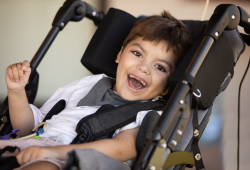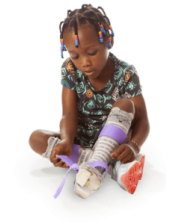How common is cerebral palsy?
 Cerebral palsy statistics show that roughly 1 in 345 children in the United States has been diagnosed with this condition. Current estimates of cerebral palsy prevalence are as high as 3 cases per 1,000 children in some studies.
Cerebral palsy statistics show that roughly 1 in 345 children in the United States has been diagnosed with this condition. Current estimates of cerebral palsy prevalence are as high as 3 cases per 1,000 children in some studies.
Each year, up to 10,000 babies are born who will eventually be diagnosed with cerebral palsy. In addition, almost 1,500 children are diagnosed later, often after delays in walking or movement become more noticeable.
This delay in diagnosis is common because early signs of cerebral palsy are often hard to recognize. Most children with cerebral palsy are not formally diagnosed with CP until age 2 or older.
Some cases of cerebral palsy may be avoided with proper medical care and early intervention, according to the Centers for Disease Control and Prevention (CDC).
Preventable cerebral palsy is often linked to complications during labor and delivery, such as oxygen deprivation or delayed emergency care. In these situations, families may be eligible to pursue financial compensation through a cerebral palsy lawsuit.
Cerebral Palsy Guide works with a network of top CP lawyers across the country who can help families in all 50 states.
Our legal partners have recovered over $1 billion for preventable birth injuries like cerebral palsy.
Get a free case review now to see if you may qualify for financial support to help cover the costs of your child’s lifelong care.
Quick facts on cerebral palsy incidence
Cerebral palsy is one of the most common childhood disabilities. To help families better understand their child’s condition, the team at Cerebral Palsy Guide has compiled some of the most important cerebral palsy statistics.
- Cerebral palsy is the most common motor disability diagnosed in early childhood.
- Roughly 1 in 345 children in the United States has cerebral palsy.
- Spastic cerebral palsy is the most common type, making up about 80% of cases.
- Cerebral palsy is more common in Black children than in White children.
- Up to 90% of CP cases begin before or during birth, not after.
- Most children with CP are diagnosed by age 3, but milder cases may be identified later.
- Babies born prematurely or with low birthweight are at greater risk for cerebral palsy.
- Multiple births, especially when a twin or triplet dies, increase the risk of CP.
- Jaundice left untreated can lead to brain damage called kernicterus, a cause of CP.
- About 50% of children with cerebral palsy also have an intellectual disability.
How many people have cerebral palsy?
Cerebral palsy incidence estimates show that about 1 million people in the United States are living with this condition.
This includes both children and adults with cerebral palsy, as there’s no cure and it will affect people for their entire lives.
While survival and cerebral palsy life expectancy vary based on severity and co-occurring conditions, many individuals live well into adulthood.
How many children have cerebral palsy?
According to cerebral palsy statistics from the CDC, about 1 in 345 U.S. children has been diagnosed with some form of cerebral palsy.
That equates to roughly 3 out of every 1,000 children, though local rates may vary slightly depending on region, access to care, and risk factors such as premature birth or low birthweight.
Most children with cerebral palsy are diagnosed between the ages of 1 and 3, with some milder cases identified later as delays in development become more noticeable.
Cerebral palsy statistics worldwide
Globally, an estimated 18 million people of all ages live with cerebral palsy. Cerebral palsy incidence varies by region. Some countries have better access to medical care during pregnancy and birth, which helps lower the risk.
In wealthier countries, cerebral palsy prevalence is about 1.6 per 1,000 live births. In countries with limited medical resources, the numbers are often higher, ranging from 2.3 to 3.7 cases per 1,000 children.
Where is cerebral palsy most common in the world?
Cerebral palsy is most common in countries with limited access to prenatal and newborn care. These include parts of South Asia and Africa, where babies are more likely to face problems during birth that may lead to brain damage.
For example, Moldova reported about 3.4 cases per 1,000 births, and Bangladesh had rates as high as 3.7 per 1,000 children. Cerebral palsy statistics show how important proper medical care is in preventing brain injuries that cause the condition.
Cerebral palsy birth injury statistics
CP is sometimes caused by preventable birth injuries, such as lack of oxygen, head trauma, and untreated infections.
- About 1 in 5 children with CP were born at full term and had complications during labor or delivery
- Roughly 70% of CP cases begin during pregnancy and may involve risk factors that proper care could help reduce
- Up to 30% of cases may be linked to labor and delivery issues, such as delayed C-section or birth asphyxia
Some families are told there is no way to know what caused their child’s CP. However, it is not uncommon for hospitals and health care professionals to hide mistakes that were made.
If you think your child’s cerebral palsy could have been avoided with proper care, connect with our registered nurses now. They can talk with you in confidence about what may have really happened to cause your child’s CP.
Cerebral palsy statistics and medical negligence
Most cases of cerebral palsy begin during pregnancy, and some are linked to mistakes made during labor and delivery. In these cases, medical malpractice may be to blame.
Cerebral palsy statistics show that many children with CP were born at full term and suffered complications that could have been prevented with proper medical care.
- Delayed cesarean sections (C-sections)
- Failure to monitor fetal distress
- Improper use of delivery tools like forceps or vacuum extractors
- Missed signs of infection in the newborn
If you suspect medical professionals failed to prevent your child’s CP, you may be eligible to file a cerebral palsy lawsuit and recover money for care, therapy, and future needs.
Get a free case review right now to see if you may qualify.
Cerebral palsy statistics for other causes
Around 10% of cerebral palsy cases are acquired after birth, often within the first two years of life, according to the CDC.
Common causes of these injuries are brain trauma, head injuries, and brain infections, such as meningitis.
Additionally, cerebral palsy statistics reported by Boston Children’s Hospital found that about 1 in 4 children with CP had an underlying genetic condition, even when no clear risk factors were present.
These cerebral palsy incidence findings suggest that some cases of CP may be caused or influenced by genetic mutations, not just birth injuries or complications.
Cerebral palsy statistics by risk factor
CP risk factors are variables that increase the chance of developing this condition. Here are some cerebral palsy statistics and facts on risk factors.
Age of the mother
Mothers younger than 20 and older than 34 have an increased risk of giving birth to a baby with cerebral palsy.
According to a study published in Pediatric Neurology, out of 1,319 children with CP, 19% had mothers 35 or older, and 4% of children had mothers under 20.
Economic factors
A Pediatrics study revealed that women with lower incomes tend to be at a higher risk of having a baby that develops CP.
Maternal health during pregnancy
Certain health conditions in the mother can increase the risk of cerebral palsy in a child. These conditions may affect fetal brain development or increase the chance of complications during pregnancy or delivery.
- Diabetes: Poorly controlled blood sugar during pregnancy, raising the risk of premature birth and delivery complications
- Epilepsy (seizure disorders): Seizures or certain medications during pregnancy, potentially affecting fetal brain development
- Hypertension (high blood pressure): Increased risk of placental problems and preterm birth, both linked to CP
- Intellectual or developmental disabilities: Associated with higher CP risk due to genetic or environmental factors
- Obesity: Increases the likelihood of complications like preeclampsia and emergency delivery
- Preeclampsia: Serious pregnancy complication involving high blood pressure and protein in the urine; strongly linked to preterm birth and cerebral palsy incidence
- Thyroid disorders: Abnormal hormone levels may interfere with fetal brain development
If you had any of these conditions during pregnancy and your child now has cerebral palsy, it may be worth asking whether more could have been done to protect your baby.
Call us at (855) 220-1101 or Click to Live Chat to talk through what may have gone wrong with one of our registered nurses — free of charge.
Race and ethnicity
According to one large study, Black children were 29% more likely to have cerebral palsy than White or Hispanic children.
Asian children were 20% less likely to have cerebral palsy than White children. The study found no significant difference in cerebral palsy incidence between White and Hispanic children.
Sex
Males are more likely to have cerebral palsy than females, according to the CDC.
Cerebral palsy statistics show that up to 60% of children with CP are boys, and males may have a slightly higher risk of more severe motor impairments.
The reason for these cerebral palsy statistics on gender isn’t fully understood, but researchers believe male brains may be more vulnerable to injury during early development.
Cerebral palsy statistics by type
There are four main types of cerebral palsy: spastic, athetoid (dyskinetic), ataxic, and mixed. Here are some cerebral palsy statistics and facts by type.
Spastic cerebral palsy
According to cerebral palsy statistics from the CDC, around 80% of children with the condition have spastic CP. This form makes muscles stiff, resulting in awkward movements and impaired walking ability.
The most common subtype is spastic diplegic cerebral palsy.
Athetoid cerebral palsy
Athetoid (dyskinetic) CP is usually associated with damage to parts of the brain called the basal ganglia and cerebellum, resulting in developmental delays, involuntary muscle movements, and physical difficulties.
A Swedish study on cerebral palsy statistics showed that dyskinetic cerebral palsy accounted for 15% of CP cases.
Ataxic cerebral palsy
Ataxic cerebral palsy causes a lack of coordination and balance. It is the rarest type of CP. The same Swedish study revealed that ataxic CP accounted for 6% of CP cases.
Mixed cerebral palsy
Damage to different parts of the brain may cause children to develop a combination of two or more types of CP. This is known as mixed cerebral palsy and accounts for 15.4% of all cases. The most common mixed type CP is a combination of spastic and dyskinetic.
Download our comprehensive free guide to access more information and resources about cerebral palsy.
Cerebral palsy statistics on co-occurring conditions
CP often occurs with other health issues, such as autism and epilepsy. The chart below lists some cerebral palsy statistics on co-occurring health conditions according to a recent study.
| Condition | Percent affected |
|---|---|
| Chronic pain | 75% |
| Intellectual disabilities | 50% |
| Can’t walk | 33% |
| Hip displacement | 33% |
| Can’t verbally communicate | 25% |
| Epilepsy (seizure disorder) | 25% |
| Impaired vision | 10% |
| Autism spectrum disorder (ASD) | 7% |
| Impaired hearing | 5% |
Statistics of cerebral palsy costs
Unfortunately, medical costs were 10 times higher for children with CP than for children without CP or intellectual disability. The CDC estimates that it costs over $1.5 million (adjusted for 2025) to provide lifetime care for a person with cerebral palsy.
A population-based study conducted in Australia revealed that two-thirds of individuals with CP cannot actively work, which means they cannot pay for their own care.
However, when CP is caused by medical malpractice, compensation may be available through a cerebral palsy lawsuit.
Get a free case review right now to see if you may qualify.
Cerebral palsy statistics on common treatments
Although there is no cure for cerebral palsy, there are interventions that can help people with CP live full and happy lives.
Below are some cerebral palsy statistics about treatment options and success rates.
Surgery for CP
Certain cerebral palsy surgeries can help people with the condition improve their mobility.
One option is selective dorsal rhizotomy (SDR), a spinal procedure that reduces spasticity in the legs.
- 90% reported improved walking
- 87% reported improved posture and balance
- 63% reported better sitting
- 43% had less pain in the back and legs
- 33% were pain-free
Surgical outcomes vary, but for some people with CP, operations like SDR can lead to better movement and quality of life.
Therapy for CP
Most children with cerebral palsy benefit from physical therapy, occupational therapy, and speech therapy to improve movement, coordination, and communication.
Therapy is often ongoing and tailored to each child’s needs, helping them reach developmental goals and improve their quality of life.
Treatment outcomes
Approximately 40.5% of patients experienced good outcomes, according to a study by King Edward Medical University and Mayo Hospital on the effectiveness of treatment in 200 children with cerebral palsy.
Get help for a cerebral palsy diagnosis
Learning that your child has cerebral palsy can be devastating. It can also mean that your family will have expenses you couldn’t have ever prepared for, especially if your child requires extensive medical care, special equipment, and ongoing therapy.
Cerebral Palsy Guide is here to help. If you’re interested in filing a birth injury lawsuit, reach out to us now. We partner with some of the best cerebral palsy law firms in the country, and we can connect you if you qualify.
Our legal partners have recovered over $1 billion for families affected by cerebral palsy and other birth injuries.
Get started right now by calling (855) 220-1101 or filling out our contact form.





